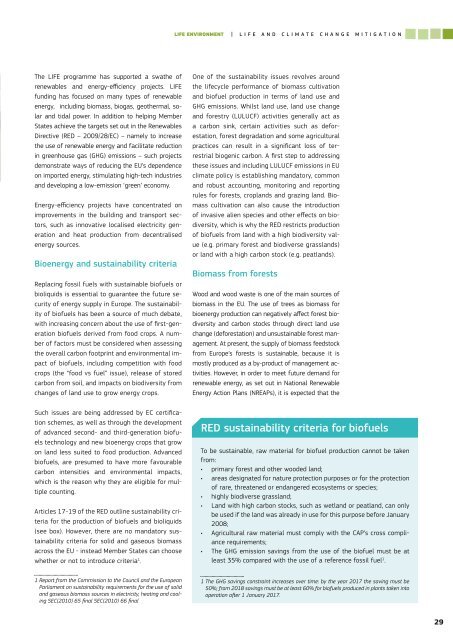Create successful ePaper yourself
Turn your PDF publications into a flip-book with our unique Google optimized e-Paper software.
LIFE ENVIRONMENT |LIFE and Climate CHANGE mitigationThe LIFE programme has supported a swathe ofrenewables and energy-efficiency projects. LIFEfunding has focused on many types of renewableenergy, including biomass, biogas, geothermal, solarand tidal power. In addition to helping MemberStates achieve the targets set out in the RenewablesDirective (RED – 2009/28/EC) – namely to increasethe use of renewable energy and facilitate reductionin greenhouse gas (GHG) emissions – such projectsdemonstrate ways of reducing the EU’s dependenceon imported energy, stimulating high-tech industriesand developing a low-emission ‘green’ economy.Energy-efficiency projects have concentrated onimprovements in the building and transport sectors,such as innovative localised electricity generationand heat production from decentralisedenergy sources.Bioenergy and sustainability criteriaReplacing fossil fuels with sustainable biofuels orbioliquids is essential to guarantee the future securityof energy supply in Europe. The sustainabilityof biofuels has been a source of much debate,with increasing concern about the use of first-generationbiofuels derived from food crops. A numberof factors must be considered when assessingthe overall carbon footprint and environmental impactof biofuels, including competition with foodcrops (the “food vs fuel” issue), release of storedcarbon from soil, and impacts on biodiversity fromchanges of land use to grow energy crops.One of the sustainability issues revolves aroundthe lifecycle performance of biomass cultivationand biofuel production in terms of land use andGHG emissions. Whilst land use, land use changeand forestry (LULUCF) activities generally act asa carbon sink, certain activities such as deforestation,forest degradation and some agriculturalpractices can result in a significant loss of terrestrialbiogenic carbon. A first step to addressingthese issues and including LULUCF emissions in EUclimate policy is establishing mandatory, commonand robust accounting, monitoring and reportingrules for forests, croplands and grazing land. Biomasscultivation can also cause the introductionof invasive alien species and other effects on biodiversity,which is why the RED restricts productionof biofuels from land with a high biodiversity value(e.g. primary forest and biodiverse grasslands)or land with a high carbon stock (e.g. peatlands).Biomass from forestsWood and wood waste is one of the main sources ofbiomass in the EU. The use of trees as biomass forbioenergy production can negatively affect forest biodiversityand carbon stocks through direct land usechange (deforestation) and unsustainable forest management.At present, the supply of biomass feedstockfrom Europe’s forests is sustainable, because it ismostly produced as a by-product of management activities.However, in order to meet future demand forrenewable energy, as set out in National RenewableEnergy Action Plans (NREAPs), it is expected that theSuch issues are being addressed by EC certificationschemes, as well as through the developmentof advanced second- and third-generation biofuelstechnology and new bioenergy crops that growon land less suited to food production. Advancedbiofuels, are presumed to have more favourablecarbon intensities and environmental impacts,which is the reason why they are eligible for multiplecounting.Articles 17-19 of the RED outline sustainability criteriafor the production of biofuels and bioliquids(see box). However, there are no mandatory sustainabilitycriteria for solid and gaseous biomassacross the EU - instead Member States can choosewhether or not to introduce criteria 1 .RED sustainability criteria for biofuelsTo be sustainable, raw material for biofuel production cannot be takenfrom:• primary forest and other wooded land;• areas designated for nature protection purposes or for the protectionof rare, threatened or endangered ecosystems or species;• highly biodiverse grassland;• Land with high carbon stocks, such as wetland or peatland, can onlybe used if the land was already in use for this purpose before January2008;• Agricultural raw material must comply with the CAP’s cross compliancerequirements;• The GHG emission savings from the use of the biofuel must be atleast 35% compared with the use of a reference fossil fuel 1 .1 Report from the Commission to the Council and the EuropeanParliament on sustainability requirements for the use of solidand gaseous biomass sources in electricity, heating and coolingSEC(2010) 65 final SEC(2010) 66 final1 The GHG savings constraint increases over time: by the year 2017 the saving must be50%; from 2018 savings must be at least 60% for biofuels produced in plants taken intooperation after 1 January 2017.29


